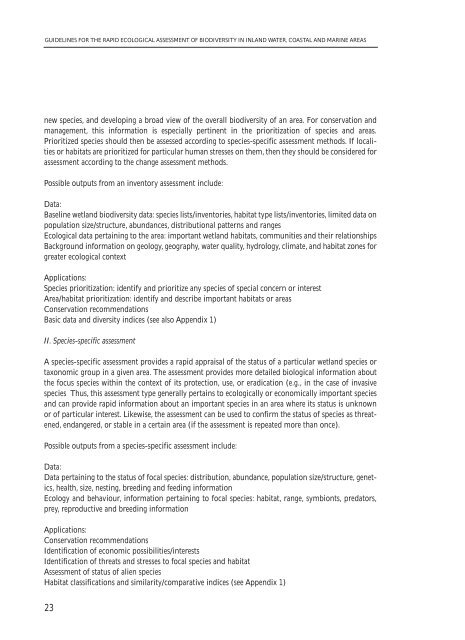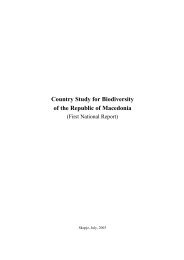Guidelines for the Rapid Ecological Assessment - Convention on ...
Guidelines for the Rapid Ecological Assessment - Convention on ...
Guidelines for the Rapid Ecological Assessment - Convention on ...
Create successful ePaper yourself
Turn your PDF publications into a flip-book with our unique Google optimized e-Paper software.
GUIDELINES FOR THE RAPID ECOLOGICAL ASSESSMENT OF BIODIVERSITY IN INLAND WATER, COASTAL AND MARINE AREAS<br />
new species, and developing a broad view of <str<strong>on</strong>g>the</str<strong>on</strong>g> overall biodiversity of an area. For c<strong>on</strong>servati<strong>on</strong> and<br />
management, this in<str<strong>on</strong>g>for</str<strong>on</strong>g>mati<strong>on</strong> is especially pertinent in <str<strong>on</strong>g>the</str<strong>on</strong>g> prioritizati<strong>on</strong> of species and areas.<br />
Prioritized species should <str<strong>on</strong>g>the</str<strong>on</strong>g>n be assessed according to species-specific assessment methods. If localities<br />
or habitats are prioritized <str<strong>on</strong>g>for</str<strong>on</strong>g> particular human stresses <strong>on</strong> <str<strong>on</strong>g>the</str<strong>on</strong>g>m, <str<strong>on</strong>g>the</str<strong>on</strong>g>n <str<strong>on</strong>g>the</str<strong>on</strong>g>y should be c<strong>on</strong>sidered <str<strong>on</strong>g>for</str<strong>on</strong>g><br />
assessment according to <str<strong>on</strong>g>the</str<strong>on</strong>g> change assessment methods.<br />
Possible outputs from an inventory assessment include:<br />
Data:<br />
Baseline wetland biodiversity data: species lists/inventories, habitat type lists/inventories, limited data <strong>on</strong><br />
populati<strong>on</strong> size/structure, abundances, distributi<strong>on</strong>al patterns and ranges<br />
<str<strong>on</strong>g>Ecological</str<strong>on</strong>g> data pertaining to <str<strong>on</strong>g>the</str<strong>on</strong>g> area: important wetland habitats, communities and <str<strong>on</strong>g>the</str<strong>on</strong>g>ir relati<strong>on</strong>ships<br />
Background in<str<strong>on</strong>g>for</str<strong>on</strong>g>mati<strong>on</strong> <strong>on</strong> geology, geography, water quality, hydrology, climate, and habitat z<strong>on</strong>es <str<strong>on</strong>g>for</str<strong>on</strong>g><br />
greater ecological c<strong>on</strong>text<br />
Applicati<strong>on</strong>s:<br />
Species prioritizati<strong>on</strong>: identify and prioritize any species of special c<strong>on</strong>cern or interest<br />
Area/habitat prioritizati<strong>on</strong>: identify and describe important habitats or areas<br />
C<strong>on</strong>servati<strong>on</strong> recommendati<strong>on</strong>s<br />
Basic data and diversity indices (see also Appendix 1)<br />
II. Species-specific assessment<br />
A species-specific assessment provides a rapid appraisal of <str<strong>on</strong>g>the</str<strong>on</strong>g> status of a particular wetland species or<br />
tax<strong>on</strong>omic group in a given area. The assessment provides more detailed biological in<str<strong>on</strong>g>for</str<strong>on</strong>g>mati<strong>on</strong> about<br />
<str<strong>on</strong>g>the</str<strong>on</strong>g> focus species within <str<strong>on</strong>g>the</str<strong>on</strong>g> c<strong>on</strong>text of its protecti<strong>on</strong>, use, or eradicati<strong>on</strong> (e.g., in <str<strong>on</strong>g>the</str<strong>on</strong>g> case of invasive<br />
species Thus, this assessment type generally pertains to ecologically or ec<strong>on</strong>omically important species<br />
and can provide rapid in<str<strong>on</strong>g>for</str<strong>on</strong>g>mati<strong>on</strong> about an important species in an area where its status is unknown<br />
or of particular interest. Likewise, <str<strong>on</strong>g>the</str<strong>on</strong>g> assessment can be used to c<strong>on</strong>firm <str<strong>on</strong>g>the</str<strong>on</strong>g> status of species as threatened,<br />
endangered, or stable in a certain area (if <str<strong>on</strong>g>the</str<strong>on</strong>g> assessment is repeated more than <strong>on</strong>ce).<br />
Possible outputs from a species-specific assessment include:<br />
Data:<br />
Data pertaining to <str<strong>on</strong>g>the</str<strong>on</strong>g> status of focal species: distributi<strong>on</strong>, abundance, populati<strong>on</strong> size/structure, genetics,<br />
health, size, nesting, breeding and feeding in<str<strong>on</strong>g>for</str<strong>on</strong>g>mati<strong>on</strong><br />
Ecology and behaviour, in<str<strong>on</strong>g>for</str<strong>on</strong>g>mati<strong>on</strong> pertaining to focal species: habitat, range, symbi<strong>on</strong>ts, predators,<br />
prey, reproductive and breeding in<str<strong>on</strong>g>for</str<strong>on</strong>g>mati<strong>on</strong><br />
Applicati<strong>on</strong>s:<br />
C<strong>on</strong>servati<strong>on</strong> recommendati<strong>on</strong>s<br />
Identificati<strong>on</strong> of ec<strong>on</strong>omic possibilities/interests<br />
Identificati<strong>on</strong> of threats and stresses to focal species and habitat<br />
<str<strong>on</strong>g>Assessment</str<strong>on</strong>g> of status of alien species<br />
Habitat classificati<strong>on</strong>s and similarity/comparative indices (see Appendix 1)<br />
23
















